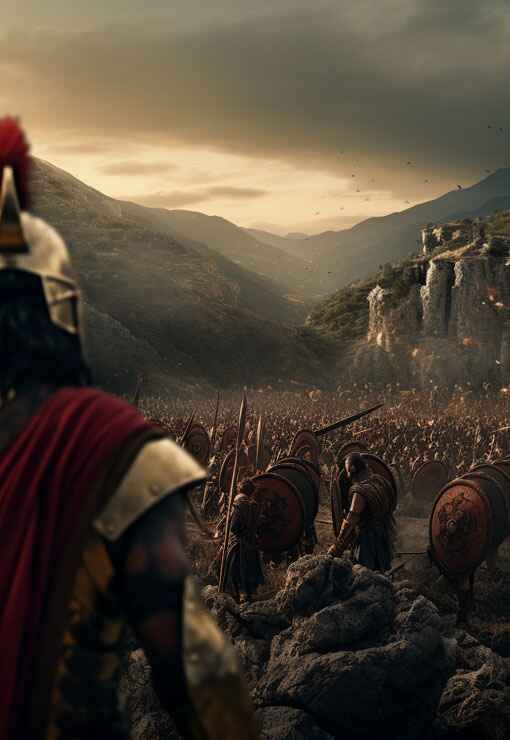

The Greek Dark Ages, spanning roughly from the 12th to the 9th century BCE, was a period of significant societal decline and cultural regression following the collapse of the Mycenaean civilisation. Here is an overview of the Greek Dark Ages:
Collapse of Mycenaean civilisation: The Greek Dark Ages were ushered in by the collapse of the Mycenaean civilisation around 1100 BCE. Various factors, including internal strife, external invasions, and possible natural disasters, contributed to the decline.
Loss of Writing Systems: The Mycenaean Linear B script, used for administrative and economic records, was lost during the Dark Ages. This resulted in a significant reduction in written documentation, limiting our understanding of the period.
Population Decline: The Dark Ages witnessed a decline in population, and many urban centres from the Mycenaean period were abandoned. The reasons for this depopulation are not fully understood but likely include economic disruptions and social upheaval.
Material Culture Regression: Material culture regressed during this period, with a decline in architectural complexity and technological achievements. The grand palaces and monumental structures of the Mycenaean era were replaced by simpler and smaller settlements.
Subsistence Agriculture: Communities during the Dark Ages reverted to subsistence agriculture, with a focus on small-scale farming. The self-sufficiency of local communities became a prominent feature of this era.
Iron Age Transition: The Dark Ages coincide with the transition from the Bronze Age to the Iron Age. The use of iron tools and weapons became more prevalent, contributing to changes in agricultural practices and warfare.
Emergence of Polis (City-States): Towards the end of the Dark Ages, there was a gradual reorganisation of society, leading to the emergence of the polis or city-state. These independent city-states became the foundational political units of classical Greece.
Geometric Period (circa 900–700 BCE): The latter part of the Dark Ages is often referred to as the Geometric Period due to the characteristic geometric motifs found on pottery and other artefacts. This period marked a slow revival in artistic expression.
Homer and Epic Poetry: The Dark Ages are associated with the oral tradition of epic poetry, including the works of Homer. The Iliad and the Odyssey, composed during this time but likely reflecting earlier traditions, preserved aspects of Mycenaean culture and provided a literary link between generations.
The Greek Dark Ages represent a transformative period in which Greek society underwent profound changes, laying the groundwork for the subsequent classical era. The emergence of city-states and the preservation of cultural traditions through oral poetry were crucial factors in the eventual resurgence of Greek civilisation.
| Start Date | 1100 BC |
|---|---|
| End Date | 750 BC |

During the Dark Ages in Greece, the use of an early form of written language, known as Linear B, was prevalent. This script, deciphered in the 1950s, provided significant insights into the administrative and economic aspects of Mycenaean civilization, shedding light on their trade, agriculture, and social structure.
Ancient Greek art and architecture, with its harmonious proportions and timeless elegance, continue to inspire awe and admiration millennia later.
Discover
Greek mythology, a rich tapestry of gods, heroes, and mythical creatures, captivates the imagination with its tales of love, betrayal, and epic adventures that delve into the depths of the human psyche.
Discover
Ancient Greek history, marked by remarkable achievements in democracy, philosophy, and warfare, shaped the foundation of Western civilization, leaving an indelible legacy of innovation and cultural influence that continues to resonate to this day.
Discover
The ancient Greek Olympics, held in Olympia every four years, celebrated athleticism, unity, and cultural pride, serving as a testament to the enduring spirit of competition and excellence that transcends time and borders.
Discover
Ancient Greek wars, such as the Persian Wars and the Peloponnesian War, were pivotal conflicts that shaped the course of history, highlighting the struggle for power, independence, and the clash of civilizations in the ancient Mediterranean world.
Discover
Ancient Greek culture and society, characterized by its emphasis on art, philosophy, and civic engagement, fostered a vibrant intellectual and social landscape where innovation flourished, democracy thrived, and the pursuit of knowledge and excellence was celebrated as fundamental values of civilized life.
Discover
Find out more about ancientgreece.com